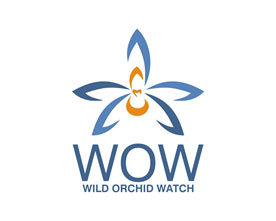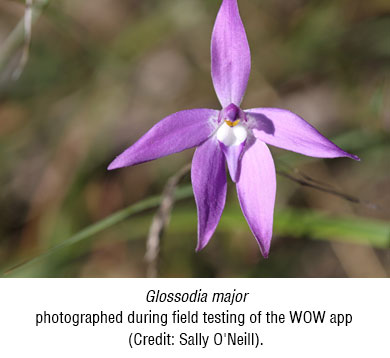<< BACK TO PROJECT LIST
Project: 327/2018
Title: Climate and habitat condition controls on orchid populations – research outcomes associated with a citizen science program
Applicant: Dr Greg Guerin
Institution: Waite Campus, The University of Adelaide

Wild Orchid Watch (WOW) is a national citizen science project that is developing tools and field methods for citizen scientists to observe and identify Australian native orchids and contribute to shared knowledge. The WOW app and website are being developed in-house at The University of Adelaide in consultation with professional ecologists and orchid enthusiasts and is scheduled for public release in 2019. Researchers and citizen scientists will be able to upload, access, use and share data on orchid populations and their habitats.
For more information about WOW, visit wildorchidwatch.org or email info@wildorchidwatch.org.
Research project
In conjunction with the WOW app and citizen science program, we will survey wild orchid populations and their habitat context, including habitat configuration, management regime, vegetation communities and climate. We will also investigate combining new, detailed observations with historical records of orchids to assess change. The research project aims to examine orchid ecology and conservation holistically by relating broader habitat parameters and environmental conditions to the presence, abundance, diversity, phenology and persistence of orchids in natural and remnant habitats in Australia. This research will detect important factors contributing to population and community declines in the context of landscape and climate change.
For more information about WOW, visit wildorchidwatch.org or email info@wildorchidwatch.org.


1. Research Outcomes
We conducted 115 surveys of orchid richness and abundance in the Mount Lofty Ranges, South Australia, to test the effects of weeds, anthropogenic disturbance, and habitat fragmentation on orchid communities. Habitat configuration in the surrounding landscape influenced the diversity of orchid communities at patch scale. Diversity was positively correlated with habitat edges in the immediate area, and with habitat cohesion at medium scales, whereas diversity was negatively correlated with increasing mean patch habitat area across larger surrounding areas. Orchids co-existed with some level of exotic species invasion but were negatively affected at higher levels of exotic species cover. Orchid communities appear to benefit from some disturbance at patch and landscape scales.
We also investigated whether floral resources for pollinators in the vegetation surrounding orchids affect fruiting success in two Australian species, Diuris pardina and Glossodia major. We surveyed 18 plots in Spring Gully Conservation Park, South Australia, and counted flowers of conspecifics and heterospecifics and returned to count the number of flowers that set fruit. Fruiting success was correlated with conspecific floral density for Diuris pardina but not G. major. No relationship was found between fruiting success and heterospecific floral resources. Fruiting success of D. pardina was positively correlated with the presence of flowering Lavandula stoechas, an invasive species.
Finally, we surveyed orchid diversity in grazing exclosures (plots fenced 5–42 years) and paired grazed control plots to test whether fencing has been an effective conservation strategy. At seven out twelve sites, fenced exclosures supported greater orchid species diversity. At three sites, unfenced areas supported more orchid species, whilst at two survey sites, orchid diversity was equal. Relative species richness across the survey sites was variable and somewhat plot-specific. The study suggests that, while heavy grazing impacts orchid diversity, some level of disturbance is required to prevent vegetation growth from crowding out orchids. Our data suggest orchid responses to environmental setting are somewhat idiosyncratic by species and site. However, a general theme was evident whereby orchid diversity is maximised by intermediate levels of disturbance. While orchids may not make ideal general ecological indicators at community level, these results give some insight into landscape management practices that favour orchid diversity.
2. Papers published as a result of this project:
Martín-Forés, I., Bywaters, S., Sparrow, B. & Guerin, G.R. (2022) Simultaneous effect of habitat remnancy, exotic species and anthropogenic disturbance on orchid diversity in South Australia. Conservation Science & Practice. DOI:10.1111/csp2.12652
Martín-Forés, I., Bywaters, S.L., Sparrow, B. & Guerin, G. (2021) Orchid fruiting success is unrelated to surrounding floral resources in South Australian plant communities. EcoEvoRxiv https://doi.org/10.32942/osf.io/q35dh
